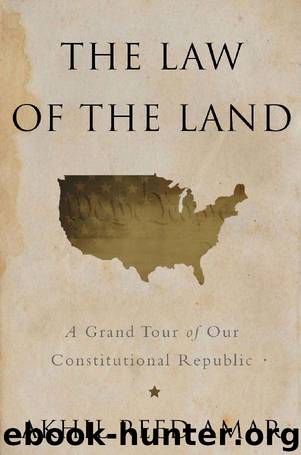The Law of the Land: A Grand Tour of Our Constitutional Republic by Akhil Reed Amar

Author:Akhil Reed Amar [Amar, Akhil Reed]
Language: eng
Format: epub
Tags: 4th Amendment, United States Constitution, 2nd Amendment, US Constitutional Law
Publisher: Basic Books
Published: 2015-04-14T06:00:00+00:00
THE JFK-LBJ AMENDMENT PASSES ITS FIRST TESTS
Having examined the main provisions and principles of the JFK-LBJ Amendment, let us now see how the amendment has operated, post-LBJ.
President Johnson himself had no occasion to invoke the amendment, but his successor, Richard Nixon, did. On October 10, 1973, Nixon’s handpicked running mate, Spiro T. Agnew, resigned his position as vice president and pled guilty to felony tax-evasion charges arising from Agnew’s shady financial dealings and bribe-taking prior to his federal service. A short two days after Agnew’s resignation—a brisk timeline in perfect keeping with the No Vacancy Principle—President Nixon nominated Gerald Ford to fill the now-empty vice presidential slot under section 2 of the JFK-LBJ Amendment. On December 6, Ford received the necessary congressional backing and took office as the first vice president ever to hold office under the JFK-LBJ Amendment.
On August 9 of the following year, Nixon himself had to resign in disgrace in the Watergate scandal. Gerald Ford immediately became president under the express provisions of section 1 of the JFK-LBJ Amendment.
By becoming president, Ford had created a vacancy in the vice presidency. Though he came into office facing a proverbial sea of troubles requiring immediate attention, Ford properly gave priority to the No Vacancy Principle. Thus, only eleven days after moving into the Oval Office—on August 20, 1974—President Ford nominated Nelson Rockefeller to fill the vacancy Ford had himself created by moving up. This time, it took Congress a full four months to say yes; and Rockefeller took office on December 19, 1974. The JFK-LBJ Amendment was less than eight years old, and already its new No Vacancy Principle had twice been put into operation.
But on both occasions, had Congress needlessly slow-walked the section 2 confirmation process? Presidents had acted promptly, and then Congress had dawdled, acting with considerable deliberation but not much speed. A cynic might wonder whether the Presidential Succession Act of 1947 was creating bad incentives, contrary to the deep principles of the JFK-LBJ Amendment. Had something terrible happened to President Nixon (a Republican) after Agnew’s resignation but before Ford’s confirmation, or, in turn, had some disaster befallen President Ford (a fellow Republican, of course) before Rockefeller was sworn in, who would have moved into the Oval Office as acting president of the United States until January 20, 1977? A Democratic Speaker of the House, pursuant to this 1947 law. So perhaps some congressional Democrats were dragging their feet and crossing their fingers. But if a Democratic Speaker of the House had moved into the White House as a result of presidential mishap and vice presidential vacancy, this statutory succession would have undermined the basic principles of Party Continuity and Handpicked Succession at the core of the JFK-LBJ Amendment.
Thus, one key implication of the foregoing analysis of the Twenty-fifth Amendment of 1967 is that the earlier Presidential Succession Act of 1947 needed and still needs to be revamped to ensure that the deep principles underlying the more recent and more sensible amendment are given their due.*
*
Download
This site does not store any files on its server. We only index and link to content provided by other sites. Please contact the content providers to delete copyright contents if any and email us, we'll remove relevant links or contents immediately.
Day by Elie Wiesel(2596)
The Age of Genius by A. C. Grayling(2393)
Gideon's Spies: The Secret History of the Mossad by Gordon Thomas(2238)
The Gulag Archipelago (Vintage Classics) by Aleksandr Solzhenitsyn(1987)
FATWA: Hunted in America by Pamela Geller(1927)
Columbine by Dave Cullen(1767)
Men Explain Things to Me by Rebecca Solnit(1609)
The Rule of Law by Bingham Tom(1594)
Examples & Explanations: Administrative Law by William F. Funk & Richard H. Seamon(1552)
Anatomy of Injustice by Raymond Bonner(1532)
Three Cups of Tea by Greg Mortenson(1518)
That Every Man Be Armed by Stephen P. Halbrook(1480)
ADHD on Trial by Michael Gordon(1474)
The Source by James A. Michener(1459)
Gideon's Spies by Gordon Thomas(1425)
Future Design by Unknown(1386)
Palestinian Walks by Raja Shehadeh(1363)
Constitutional Theory by Carl Schmitt(1347)
Fast Times in Palestine by Pamela Olson(1335)
